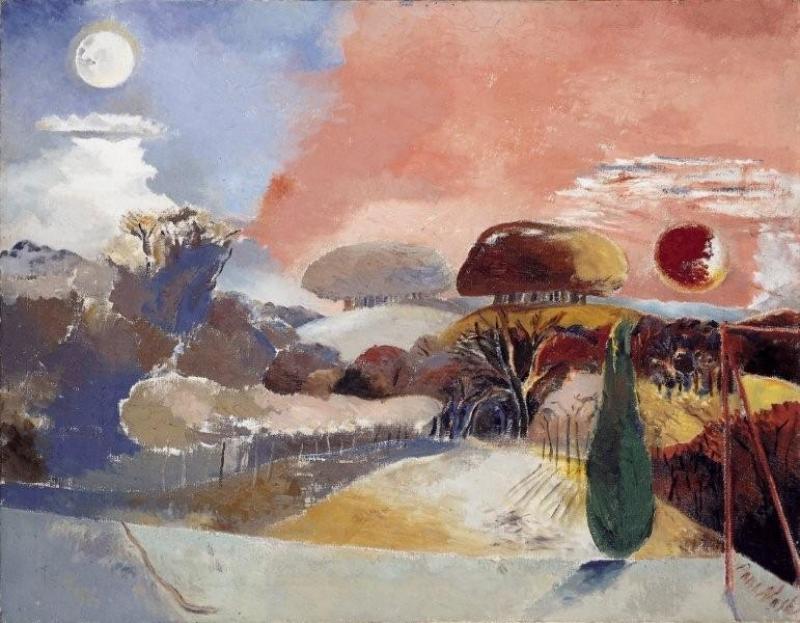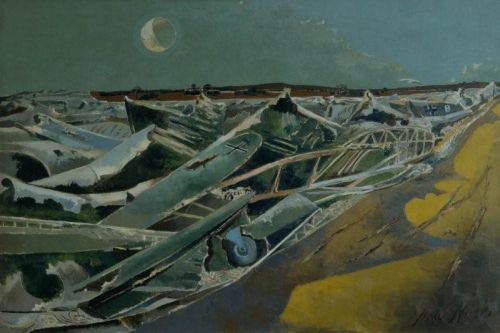Paul Nash, The Elements, Dulwich Picture Gallery | reviews, news & interviews
Paul Nash, The Elements, Dulwich Picture Gallery
Paul Nash, The Elements, Dulwich Picture Gallery
Haunting images from the underrated English master

In the mid 1940s when the Queen Mother purchased Paul Nash’s Landscape of the Vernal Equinox (1943) Princess Margaret remembers saying, “Poor Mummy’s gone mad. Look what she’s brought back.” But though this painting is one of the undoubted masterpieces of 20th-century British art, it’s easy to see why the Princess responded as she did.
The walls of the Dulwich Picture Gallery have been painted an appropriate stormcloud blue-grey; a colour both aesthetically and psychologically appropriate. Aesthetically appropriate because this sombre hue recurs over and over again as part of Nash’s typically restricted English palette. And psychologically appropriate because many of the works on show (spanning the whole of Nash’s 30-year working life) present us with an unsettled and unsettling world, neither one we are fully familiar with, nor one in which the imagination completely dominates.
The curator of The Elements, David Fraser Jenkins, has wisely avoided a straightforward, linear approach, instead giving each of the exhibition’s four rooms a theme: "Elements in Conflict", "A Path through the Elements", "Elements as Refuge", and "Elements in Harmony". And even though the work is thankfully never so accommodating as to fit neatly into any of these categories, it does mean the gallery can avoid having all the weaker more illustrative early works in one room. But what is interesting about Nash’s early works is the presence of people in them. Later he must have realised that they were diminishing the impact of his vision, because neither man nor dog, nor even sheep, haunts his mature landscapes (although birds are sometimes utilised for compositional or symbolic effect.).
But to return to the Queen mum’s favourite. If you stand before Landscape of the Vernal Equinox for any length of time its subtle beauty should gradually seep into your bones. That flat, scuppered surface of khaki and olive greens, cement-greys and wet-sand-yellows will dissipate under your focused attention, becoming a window onto a world ruled over by a huge snowball of a moon and a rust-red sun. This is landscape approached in much the same way as Nash’s contemporary Francis Bacon tackled the figure. Nash may take less savage liberties with a rolling hill than Bacon took with his poor crushed and twisted sitters, but the end result is, similarly, as much a portrait of the artist’s own troubled soul as it is a literal representation of a stretch of his beloved South Downs.

Because Paul Nash served as a war artist during the First World War, and died just after the Second, war can never have been far from his mind. But the power of both his oils and watercolours lies in how subliminally, and therefore effectively, the war features in them. Yes, there are exceptions to this rule, such as the cinematically striking Totes Meer (1940-41) (above, Tate Gallery), in which a sea of mangled German planes glints mutely in the moonlight. But overall, understatement is the key word here. War may be lurking beyond every hilltop grove, but Nash’s love of gnarled old tree trunks, monolithic chunks of stone and salmon-coloured skies allowed him to escape from the everyday into the otherworldly.
Even though we can discern the spirit of De Chirico, Rene Magritte, Samuel Palmer and even William Blake in his detached, enigmatic imagery, the work of these artists has been assimilated rather than imitated. But perhaps his most personal and intimate painting is his least typical. Interior, Pantile Cottage, Dymchurch (1925) is a Bonnard-like view of Paul and his wife Margaret’s airy bedroom. On the floor by the dressing table is a pair of black high-heeled shoes, rendered so impressionistically that they could be mistaken for birds were it not for their domestic context. Even though Paul and Margaret are conspicuous by the absence from this more carefree and sensuous work, they feel touchingly present. Perhaps because this painting feels like the only glimpse we get of a side of Nash’s life not haunted by the spectre of the battlefield.
Paul Nash, The Elements continues at the Dulwich Picture Gallery until 9 May.
Add comment
The future of Arts Journalism
You can stop theartsdesk.com closing!
We urgently need financing to survive. Our fundraising drive has thus far raised £49,000 but we need to reach £100,000 or we will be forced to close. Please contribute here: https://gofund.me/c3f6033d
And if you can forward this information to anyone who might assist, we’d be grateful.

Subscribe to theartsdesk.com
Thank you for continuing to read our work on theartsdesk.com. For unlimited access to every article in its entirety, including our archive of more than 15,000 pieces, we're asking for £5 per month or £40 per year. We feel it's a very good deal, and hope you do too.
To take a subscription now simply click here.
And if you're looking for that extra gift for a friend or family member, why not treat them to a theartsdesk.com gift subscription?
more Visual arts
 'We are bowled over!' Thank you for your messages of love and support
Much-appreciated words of commendation from readers and the cultural community
'We are bowled over!' Thank you for your messages of love and support
Much-appreciated words of commendation from readers and the cultural community
 Lee Miller, Tate Britain review - an extraordinary career that remains an enigma
Fashion photographer, artist or war reporter; will the real Lee Miller please step forward?
Lee Miller, Tate Britain review - an extraordinary career that remains an enigma
Fashion photographer, artist or war reporter; will the real Lee Miller please step forward?
 Kerry James Marshall: The Histories, Royal Academy review - a triumphant celebration of blackness
Room after room of glorious paintings
Kerry James Marshall: The Histories, Royal Academy review - a triumphant celebration of blackness
Room after room of glorious paintings
 Folkestone Triennial 2025 - landscape, seascape, art lovers' escape
Locally rooted festival brings home many but not all global concerns
Folkestone Triennial 2025 - landscape, seascape, art lovers' escape
Locally rooted festival brings home many but not all global concerns
 Sir Brian Clarke (1953-2025) - a personal tribute
Remembering an artist with a gift for the transcendent
Sir Brian Clarke (1953-2025) - a personal tribute
Remembering an artist with a gift for the transcendent
 Emily Kam Kngwarray, Tate Modern review - glimpses of another world
Pictures that are an affirmation of belonging
Emily Kam Kngwarray, Tate Modern review - glimpses of another world
Pictures that are an affirmation of belonging
 Kiefer / Van Gogh, Royal Academy review - a pairing of opposites
Small scale intensity meets large scale melodrama
Kiefer / Van Gogh, Royal Academy review - a pairing of opposites
Small scale intensity meets large scale melodrama
 Jenny Saville: The Anatomy of Painting, National Portrait Gallery review - a protégé losing her way
A brilliant painter in search of a worthwhile subject
Jenny Saville: The Anatomy of Painting, National Portrait Gallery review - a protégé losing her way
A brilliant painter in search of a worthwhile subject
 Abstract Erotic, Courtauld Gallery review - sculpture that is sensuous, funny and subversive
Testing the boundaries of good taste, and winning
Abstract Erotic, Courtauld Gallery review - sculpture that is sensuous, funny and subversive
Testing the boundaries of good taste, and winning
 Edward Burra, Tate Britain review - watercolour made mainstream
Social satire with a nasty bite
Edward Burra, Tate Britain review - watercolour made mainstream
Social satire with a nasty bite
 Ithell Colquhoun, Tate Britain review - revelations of a weird and wonderful world
Emanations from the unconscious
Ithell Colquhoun, Tate Britain review - revelations of a weird and wonderful world
Emanations from the unconscious
 Rachel Jones: Gated Canyons, Dulwich Picture Gallery review - teeth with a real bite
Mouths have never looked so good
Rachel Jones: Gated Canyons, Dulwich Picture Gallery review - teeth with a real bite
Mouths have never looked so good

Comments
...
...
Those are broken up warplanes